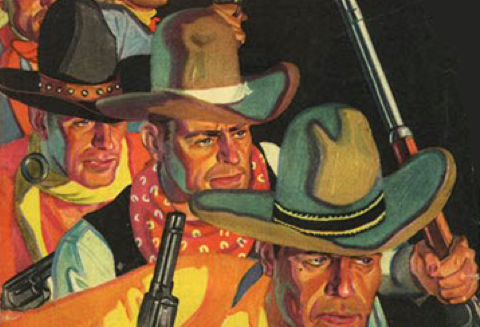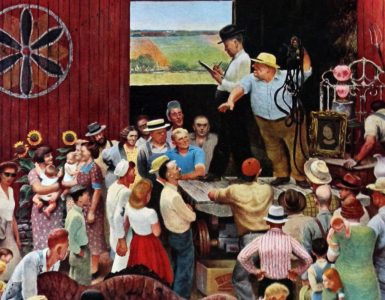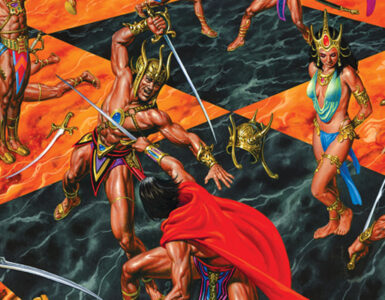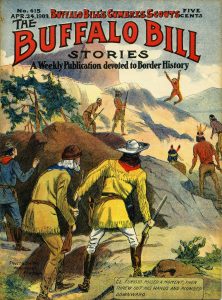 The western story got its start with James Fenimore Cooper’s Leatherstocking Tales, a series of five novels that fictionally adapted the adventures of frontiersman Daniel Boone. In the years following Cooper’s Natty Bumppo stories, authors such as Bret Harte, Francis Parkman, and Mark Twain further expanded the field.
The western story got its start with James Fenimore Cooper’s Leatherstocking Tales, a series of five novels that fictionally adapted the adventures of frontiersman Daniel Boone. In the years following Cooper’s Natty Bumppo stories, authors such as Bret Harte, Francis Parkman, and Mark Twain further expanded the field.
According to an essay written by pulp author John A. Saxon and published in 1945 by WRITER’S DIGEST, the western story became a genre of its own during the second half of the 19th century. In 1869, writer Edward Zane Carroll Judson convinced hunter, scout, and showman William F. Cody to lend his name and reputation to a fictionalized account of his life, “Buffalo Bill, King of the Borderman,” originally serialized in Street & Smith’s NEW YORK WEEKLY. Phenomenally received, Judson found a public hungry for further adventures of the real life hero of the American frontier. Thus started “. . . the fictionalized form of the Western story . . . based partly on fact, but mostly on imagination.”
Given the great success of Street & Smith’s Buffalo Bill tales, nickel weeklies and dime novels devoted to western heroes and outlaws soon followed: DEADWOOD DICK LIBRARY, DIAMOND DICK LIBRARY, JAMES BOYS WEEKLY, KLONDIKE KIT LIBRARY, WILD WEST WEEKLY, and more. These as well as stories featuring detective heroes such as Nick Carter and Old Sleuth and sports heroes such as Frank Merriwell, reigned supreme for nearly forty years. Then, following the introduction of the pulp magazine by Frank A. Munsey in 1896, the story papers and dime novels began to give way to the more economical rough-paper periodicals.
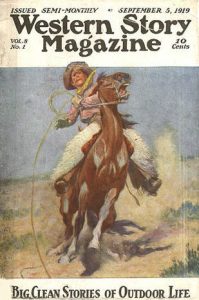 The first all-western pulp magazine was introduced by Street & Smith when they converted their tired old story paper, NEW BUFFALO BILL WEEKLY, to WESTERN STORY MAGAZINE with its September 5, 1919 number. Within a year, the magazine reached a circulation of 300,000 copies and began to be released weekly, a status it enjoyed for the next twenty-five years. Soon thereafter, the magazine began publishing the western fantasies of poet turned pulp writer Frederick Schiller Faust – better known as Max Brand – and really took off. By the late 1920s, WESTERN STORY was competing against countless imitators – ACE-HIGH, COWBOY STORIES, FRONTIER, GOLDEN WEST, LARIAT, NORTH-WEST STORIES, RANCH ROMANCES, WEST, and others.
The first all-western pulp magazine was introduced by Street & Smith when they converted their tired old story paper, NEW BUFFALO BILL WEEKLY, to WESTERN STORY MAGAZINE with its September 5, 1919 number. Within a year, the magazine reached a circulation of 300,000 copies and began to be released weekly, a status it enjoyed for the next twenty-five years. Soon thereafter, the magazine began publishing the western fantasies of poet turned pulp writer Frederick Schiller Faust – better known as Max Brand – and really took off. By the late 1920s, WESTERN STORY was competing against countless imitators – ACE-HIGH, COWBOY STORIES, FRONTIER, GOLDEN WEST, LARIAT, NORTH-WEST STORIES, RANCH ROMANCES, WEST, and others.
Following the collapse of the world economy in 1929, ten-cent western pulps began to flood the market as publishers sought reliable markets to help them keep afloat. Beginning with DIME WESTERN MAGAZINE — introduced by Popular Publications in late 1931 — many western pulps took on a more mature, often violent tone. Others, including Ned Pines’ Standard Magazines, coupled the western with the highly popular single character magazine. With managing editor Leo Margulies riding herd over “thrilling tales of the gallant West where danger lurks and cowboys are supermen,” Standard introduced Jim Hatfield in TEXAS RANGERS, Wayne Morgan in MASKED RIDER WESTERN, and other western pulp superheroes in their own magazines.
Street & Smith’s WESTERN STORY MAGAZINE would last for thirty years and nearly 1300 issues. Following its launch in 1919, it would change the pulp fiction magazine industry forever. At its peak, it was released once a week and sold 500,000 copies of each issue. Like its predecessor in the specialty pulp market — DETECTIVE STORY MAGAZINE — it inspired a host of imitators and fostered the western genre, helping the pulps to survive the Great Depression and the Second World War.
At 10:30 PM on Friday, July 22, please join noted popular culture historian Will Murray to PulpFest‘s programming stage in the Union Rooms on the second floor of the Hyatt Regency Columbus for an examination of “WESTERN STORY MAGAZINE and the Evolution of the Pulp Western,” part of our celebration of “A Century of the Specialty Pulp.”
Will Murray has been researching and writing about the pulps for nearly half a century. One of the most respected authorities on the pulp magazine, having authored countless articles and books, including WORDSLINGERS: AN EPITAPH FOR THE WESTERN, Murray was the ghost-writer for about forty of the Destroyer action-adventures novels. He has also written nineteen Doc Savage novels and a fully authorized Tarzan novel, RETURN TO PAL-UL-DON. A second is forthcoming.
 Start making your plans to attend “Summer’s AMAZING Pulp Con” as we salute 100 years of the specialty pulp from July 21 through July 24 in the Columbus, Ohio Arena district at the Hyatt Regency hotel and the city’s spacious convention center. “You’ll have a rip-snorting time” at the pop culture center of the universe. Please remember that the Hyatt Regency Columbus is sold out of rooms for July 21 through July 23. At www.columbusconventions.com/thearea.php, you’ll find a list of area hotels courtesy of the Greater Columbus Convention Center. Alternately, you can search for a room at tripadvisor or a similar website to find a hotel near the convention. Thanks so much to everyone who has reserved a room at our host hotel. By staying at the Hyatt Regency, you’ve helped to ensure the convention’s success.
Start making your plans to attend “Summer’s AMAZING Pulp Con” as we salute 100 years of the specialty pulp from July 21 through July 24 in the Columbus, Ohio Arena district at the Hyatt Regency hotel and the city’s spacious convention center. “You’ll have a rip-snorting time” at the pop culture center of the universe. Please remember that the Hyatt Regency Columbus is sold out of rooms for July 21 through July 23. At www.columbusconventions.com/thearea.php, you’ll find a list of area hotels courtesy of the Greater Columbus Convention Center. Alternately, you can search for a room at tripadvisor or a similar website to find a hotel near the convention. Thanks so much to everyone who has reserved a room at our host hotel. By staying at the Hyatt Regency, you’ve helped to ensure the convention’s success.
(THE BUFFALO BILL STORIES was the first publication devoted to fiction about frontiersman William F. Cody. A weekly publication “devoted to border history,” it debuted with its May 18, 1901 number and was published by Street & Smith. To learn more about the evolution of the pulp western, read John Dinan’s THE PULP WESTERN, Ron Goulart’s CHEAP THRILLS, and Will Murray’s WORDSLINGERS. Then come to PulpFest 2016 and hear Will Murray discuss the genre’s roots and development.
According to dime novel scholar J. Randolph Cox, most of the covers for Street & Smith periodicals published during the early 1900s were drawn by Charles L. Wrenn, Marmaduke Russell, Ed Johnson, and J. A. Cahill. The particular artist of the April 24, 1909 issue — pictured above — is not known.
The work of Stanley L. Wood — an English illustrator noted for his paintings featuring horses in action, often featured with boys’ adventure stories — was used as the cover art to the first issue of WESTERN STORY MAGAZINE, dated September 5, 1919. Later issues of the rough paper magazine — including the December 12, 1931 number — featured covers by the “King of the Pulps,” Walter M. Baumhofer. The artist is best remembered for his classic covers that appeared on DOC SAVAGE MAGAZINE.)

